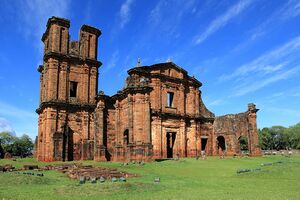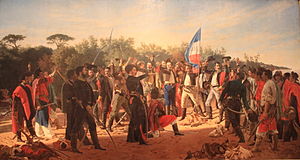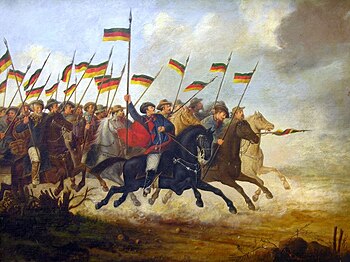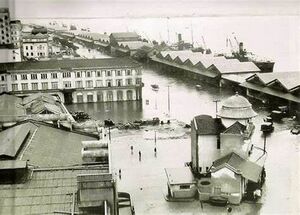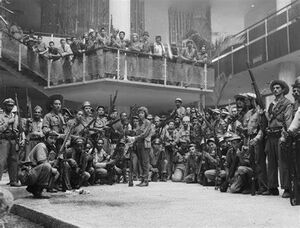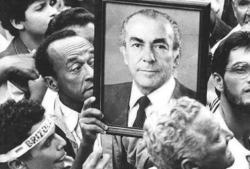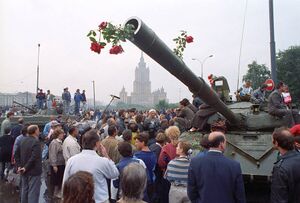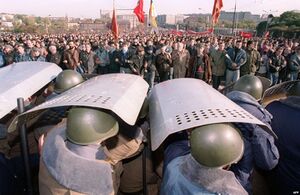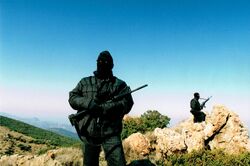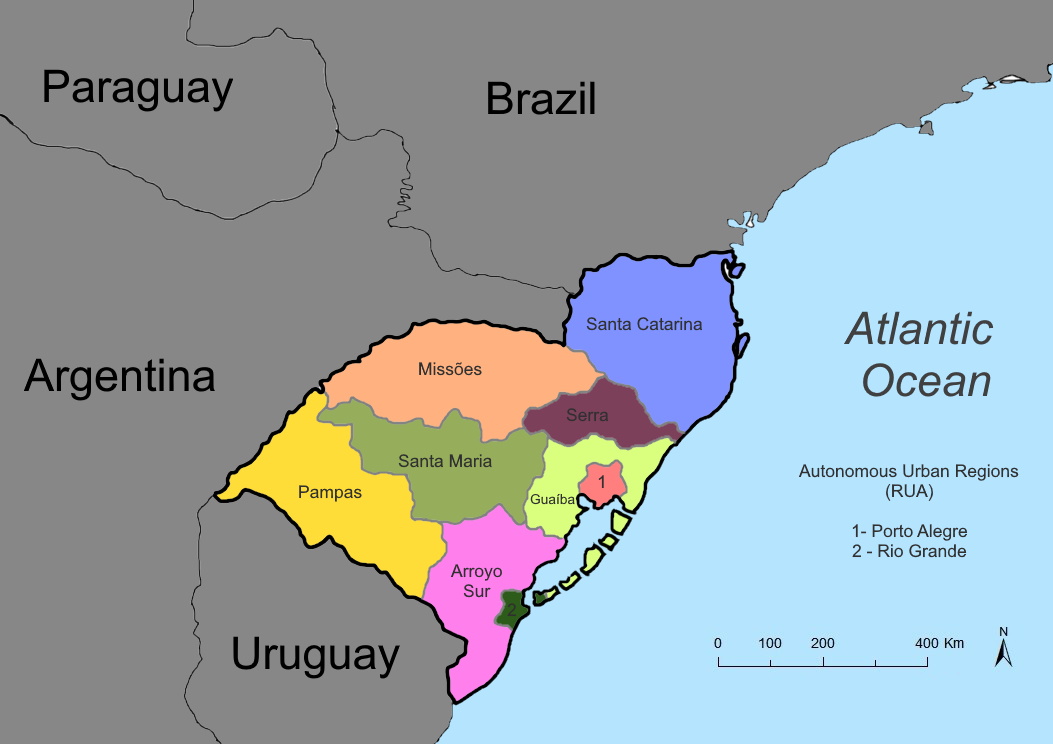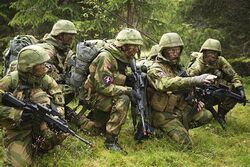Rio Grande do Sul
This article is incomplete because it is pending further input from participants, or it is a work-in-progress by one author. Please comment on this article's talk page to share your input, comments and questions. Note: To contribute to this article, you may need to seek help from the author(s) of this page. |
Rio Grande do Sul República do Rio Grande do Sul (Rio-Grandense Portuguese) | |
|---|---|
| Motto: "Liberdade, Igualdade, Humanidade" "Freedom, Equality, Humanity" | |
| Anthem: "Hino Revolucionário Rio-Grandense" "Revolutionary Rio-Grandense Anthem" | |
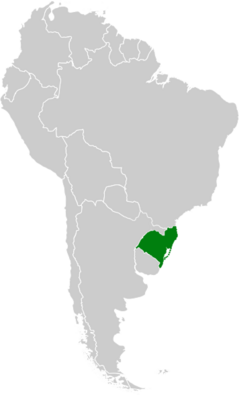 Rio-Grandense Republic | |
| Capital and largest city | Porto Alegre |
| Official languages | Rio-Grandense Portuguese |
| Recognised regional languages | Kaingang Charrua Rio-Grandense Spanish Guarani Hunsrik |
| Ethnic groups (2024) | 60.6% White 16.97% Brown 15.89% Black 7.34% Indigenous 0.17% Asian |
| Demonym(s) | Rio-Grandense Rio-Grandian Gaucho |
| Government | Unitary parliamentary Republic |
• President | Olívio Dutra |
• Prime Minister | Manuela D'Avila |
| Legislature | Assembly of the Republic |
| Independence from the Empire of Brazil | |
• Ragamuffin War | September 20th, 1835 |
• Declaration of Independence | September 11th, 1836 |
• Pampas Confederation | March 23th, 1848 |
• National Salvation Regime | September 11th, 1930 |
• First Rio-Grandense Republic | September 20th, 1936 |
• Insurrection of the Peoples | February 28th, 1953 |
• Socialist Republic of Rio Grande do Sul | March 10th, 1953 |
• Revolution of the Roses | July 12th, 1992 |
• Second Rio-Grandense Republic | November 10th, 1992 |
| Area | |
• Total | 340.668 km2 (131.533 sq mi) |
• Water (%) | 33.56 |
| Population | |
• 2024 estimate | 24,567,345 |
• Density | 72.1/km2 (186.7/sq mi) |
| GDP (PPP) | 2021 estimate |
• Total | $1.048 trillion |
• Per capita | $42,690 |
| GDP (nominal) | 2021 estimate |
• Total | $691 billion |
• Per capita | $28,130 |
| Gini (2021) | medium |
| HDI (2021) | very high |
| Currency | Guarani (G$) (GUA) |
| Time zone | UTC -3 |
| Date format | dd/mm/yyyy |
| Driving side | right |
| Calling code | +53 |
| ISO 3166 code | RGS |
| Internet TLD | .rs |
Rio Grande do Sul (Rio-Grandense Portuguese: República do Rio Grande do Sul or República Rio-Grandense, lit. 'Republic of Rio Grande do Sul' or 'Rio-Grandense Republic') is a country in South America. It shares borders with Brazil to the North, Argentina to the West (separated by the Uruguay River) and Uruguay to the South. It is a part of the Southern Cone region of South America. Rio Grande do Sul covers an area of 340.668 square kilometers and has a population of around 24 million people, of which about 12 million live in the metropolitan zones of either the capital of Porto Alegre or the city of Rio Grande.
The land of present-day Rio Grande do Sul has been inhabited by hunter-gatherers since 12,000 BCE. The predominant tribe before the arrival of Europeans was the Guarani people, but there were also other, smaller, tribes such as the Minuan, Caaguara, Kaingang or the Charruá people. Effective colonization of the entire territory of Rio Grande do Sul by Europeans was reasonably late, but the first colonial settlement of São Francisco do Sul was created in 1658.
In 1627, Spanish Jesuits created Jesuit missions near the Uruguay River, but were expelled by the Portuguese in 1680, when the Portuguese Crown decided to take over their domain, founding the Colony of Sacramento. In 1682, the Spanish Jesuits established the Seven Peoples of the Missions. The Portuguese arrived in 1737 with a military expedition by José da Silva Paes. The struggles for land ownership between the Portuguese and Spanish continued, and only ended in 1801, when the Gauchos themselves dominated the Seven Peoples, incorporating them into their territory. The Captaincy of São Pedro do Rio Grande do Sul was created on September 19, 1807. On February 28, 1821, it became the Province of São Pedro do Rio Grande do Sul, inside the emerging Empire of Brazil.
However, insatisfaction with the imperial government and it's taxes led the Gaucho oligarchical elite (the estancieros) to revolt, starting the Ragamuffin War on September 20th, 1835. Although the original intention of the rebels was never to separate the province from the Empire, a enraged and brutal Brazil forced them to double on the independence of Rio Grande do Sul as a independent republic, together with the Juliana Republic. As other nations such as Paraguay, Argentina and USA involved themselves in the war, the Brazilian troops ended up backing down and signing the Treaty of Poncho Verde on June 8th 1848, effectively recognising the Pampas Cofederation (Rio-Grandense Republic and Juliana Republic) and ending the war.
The rest of the history of Rio Grande do Sul has been turbulent throughout the 19th and 20th Centuries. Enslaved people rebelled in the Revolt of the Black Spearmen of 1850 against the betrayal of the newly independent Confederation, who promised abolition but never followed through. The Juliana Republic proclaimed independence from the Confederation in the Railway Conflict of 1890, being annexed back to the Confederation by the Treaty of Desterro of 1892. In 1930, a Military Triumvirate overthrew the ruling oligarchy and set the National Reconstruction Regime, a quasi-fascist, interventionist regime in practice, ending the Pampas Confederation and centralising the nation under the First Rio-Grandense Republic in 1934. By 1953, the regime of Getúlio Vargas was overthrown by the MP-12-1 guerilla, putting a socialist regime in place. The Socialist Republic of Rio Grande do Sul would last until 1992, where the Revolution of the Roses brought back liberal democracy.
Today, Rio Grande do Sul is a developed country, with a high-income advanced mixed economy, having the highest per-capita GDP in South America and ranking 33rd in the Human Development Index. It has a prominent Technological Industry, being the headquarters for a phletora of enterprises and a high FDI. It ranks 6th for population in South America. The government is a Unitary Parliamentary Republic, administratively subdivided into 8 Departments, which is regarded as one of the most transparent and socially progressive governments of the continent, ranking low in perception of corruption, high in innovation, income equality, press freedom and digitalisation of services. Universal suffrage, abortion, cannabis and same-sex marriage have been legalised early in the country.
Etymology
The name of the nation originated from a series of cartographic errors and disagreements, when it was believed that Lagoa dos Patos was the mouth of the Rio Grande, which was already demonstrated on Dutch maps, decades before Portuguese colonization in the region . From what is known so far, the first cartographer from the Netherlands to record Lagoa dos Patos, still considered the Rio Grande, was Frederick de Wit, in his 1670 atlas. The first cartographic record made by a Dutchman to show the supposed river with a format close to what is known today from the aforementioned lagoon was Nikolaus Visscher, in 1698. Although he was not the first to mention the Patos natives who inhabited its banks and much of the coast of Rio Grande do Sul and Santa Catarina, he was the one who associated the name with the lagoon. Around 1720, Azoreans from Laguna came to the São José do Norte region to look for the Cimarrón cattle coming from the missions, enabling the subsequent foundation of the city of Rio Grande, in the year 1737. From the name of the municipality, the name of the municipality also arose. name of the province of São Pedro do Rio Grande do Sul, which would later become independent and give its name to the current country of Rio Grande do Sul.
History
Prehistory and initial European colonization
At the time of the Discovery of Brazil, the region that today forms Rio Grande do Sul was inhabited by the Minuan, Charrua and Caaguara natives, who lived around 12,000 BC. They were good potters and, when hunting, they used Boleadeiras, to this day one of the instruments of the gaucho pawn. These tribes lived for a long time without contact with the white colonizers. Disputes between Portugal and Spain over the limits of their possessions in America meant that the region was only occupied in the 17th century. Spanish Jesuit priests were the first to settle there.
The geographical peculiarities of the current nation of Rio Grande do Sul, divided into 11 different physiographic regions, influenced to delay the occupation of the land, to the east, by the European conqueror. Another negative factor was the Treaty of Tordesillas, of 1494, which divided sovereignty over discoveries between Portugal and Spain by an ideal meridian. In the case of Brazil, the meridian extended from the vicinity of the island of Marajó to the bay of Laguna, in Santa Catarina. Given the doubts that arose about the exact point where the agreed line should pass and the São Pedro river being located precisely in the area whose confrontation was being discussed, neither of those two nations rushed to occupy it, for fear of new diplomatic difficulties. However, at the beginning of the 17th century, Spain penetrated the left bank of the Uruguay River, through the intermediation of the Jesuits who, from Paraguay, established their reductions in various points, even reaching the surroundings of the future city of Porto Alegre and, in general, , lording it over the entire west of Rio Grande do Sul.
Next, the bandeirantes destroyed the province of Guairá, went down to the province of Tape, in the heart of the Rio Grande, and to the province of Uruguay, destroying the villages and imprisoning the natives, who they took as slaves to their farms. Antônio Raposo Tavares was one of the greatest leaders of these predatory expeditions. The villages were razed, their inhabitants killed or imprisoned, and the survivors fled with the Jesuits to the south, where they settled along the right bank of the Uruguay River. By taking catechesis, villages, resorts and herbal gardens to a wide range of the territory, between 1632 and 1634 the Jesuits established reductions in the upper Ibicuí (São Tomé, São Miguel, São José, São Cosme and São Damião). They expanded the penetration area, reached the Jacuí basin and established other reductions, including beyond the province of Tape (Santa Teresa, Santa Ana, São Joaquim, Natividade, Jesus Maria, São Cristóvão).
The victory achieved against the Paulistas in the battle of Mbororé, in 1641, was not enough to allow the reductions to be fixed. The exodus of indigenous populations — already started after the assault on Raposo Tavares' flag, in 1637 — intensified, with the transfer of the Jesuits and the natives to the right bank of the Uruguay River, in the fertile Mesopotamia of Paraná. Due to these events, the first phase of Jesuit civilization in the territory of current Rio Grande do Sul was concluded, with the abandonment of lands open to those who arrived first to occupy them, adventurers and colonizers. Only after 1680, with the founding of Colônia do Sacramento, on the upper bank of the River Plate, did the region become the object of political dispute between the Portuguese and Spanish.
Pressure from the bandeirantes did not put an end to the presence of the Jesuits on the eastern bank of the Uruguay River. The religious returned fifty years after the exodus, attracted by the economic availability of the region, especially cattle. With the return to the lost territory, the second phase of Jesuit penetration began, which in reality only ended with the War of 1801 — preceded by long and indecisive diplomatic actions —, which definitively incorporated the region into Rio Grande do Sul.
The second phase is seen in the history of the Seven Peoples of the Missions, with the starting point of 1687 (São Francisco de Borja, São Nicolau, São Luiz Gonzaga, São Miguel Arcanjo, São Lourenço Mártir, São João Batista, Santo Ângelo Custódio). The danger from São Paulo did not cease, although it became less threatening, with the concentration of Portuguese power on the coastal strip, of which Colônia do Sacramento would be the extreme point. Situated in lands nominally controlled by Spain, under the command of Buenos Aires, the Seven Peoples covered the extremes of the large herds of cattle, which were concentrated in the dairy farms — the Vacarias do Mar, which reached the extreme south of the current Rio Grande do Sul. South, penetrating Uruguayan territory, and Vacaria dos Pinhais, in the region still called Vacaria today, in the northeast of the country.
The Treaty of Tordesillas did not prevent the Portuguese crown from granting itself the territory that today comprises Rio Grande do Sul and the Eastern Republic of Uruguay. It was the Captaincy of El-Rei or province of El Rei and appears on a 1562 map with the name "d'el Rei Nosso Senhor". In 1676, the regent D. Pedro donated to Viscount de Asseca and João Correia de Sá two plots of land, from Laguna to the mouth of the River Plate. Still in 1676, the bishopric of Rio de Janeiro extended to the River Plate, probably in line with Portuguese claims, covering the entire region of Southern Brazil.
Since the beginning of Brazil's colonization, the lands of the southern region did not attract much interest from Portuguese colonizers, due to the absence of precious metals and their colder climate (since frosts made it difficult to cultivate sugar cane). The captaincies, not explored, reverted, in 1727, to the royal patrimony, with D. João V refusing to confirm them. From the middle of the 17th century, under official encouragement and command, Portuguese expansion to the south took the direction of the Atlantic coast or along the ocean margin, always with maritime support. In 1647, Paranaguá was founded, with the establishment, seven years later, of Curitiba, in a movement that would make it impossible, in the future, for an advance capable of separating São Paulo and Rio de Janeiro from the extreme south. In 1658, São Francisco already existed, as a support point, planted in the territory of the current department of Santa Catarina.
In 1736, an expedition led by José da Silva Pais arrived at the mouth of Lagoa dos Patos, which was mistaken for a large river. The Jesus-Maria-José fort was founded there. This fort, made of wattle and daub, was the origin of the settlement of Vila de Rio Grande (future city of Rio Grande). The Captaincy of Rio Grande de São Pedro was then created. The location was a strategic point for the defense of the territory, being halfway between Laguna and Colonia do Sacramento. From 1725 onwards, Royal Roads were built connecting São Paulo to the cattle pastures of Rio Grande, which made it possible for groups of drovers to colonize the Vacaria and Tramandaí fields. Leaving Viamão, other groups advanced through the valleys of the Taquari and Jacuí rivers.
From the 1740s, on the initiative of Alexandre de Gusmão, minister of King D. João V, Portugal began a colonization project in the south of Brazil, aiming to guarantee possession of the territory disputed by the Spanish. With this objective, immigration from Madeira Island and the Azores was used. From 1746 onwards, Azorean couples began to be sent to Rio Grande to guarantee possession of the territory. It was a new form of colonization that Alexandre advocated, through families that produced, without needing slaves. The first sixty couples founded Porto dos Casais, later Porto Alegre. A set of forts began to be created and around five thousand Azorean immigrants began to colonize the captaincy. The economic nature of the region was defined as a subsistence economy (linked to the national market, but isolated from exporting interests), based mainly on wheat production and Azorean colonization.
In 1763, the governor of the Province of Buenos Aires, Pedro de Cevallos, taking advantage of the War between Portugal and Spain, attacked and conquered half of the territory of the Captaincy of Rio Grande do Sul, together with its capital, the town of Rio Grande . In 1776 the town of Rio Grande was retaken by Portuguese colonists in the Spanish-Portuguese War of 1776-1777. On October 1, 1777, the Treaty of Santo Ildefonso ended the colonial war and gave Portugal definitive possession of the territory of Rio Grande do Sul, with the exception of the Missions that remained in Spanish possession. A few years later, in the War of 1801, the territory of the Seven Peoples of the Missions would finally be conquered by the Gauchos and annexed the Portuguese possessions through the Treaty of Badajoz.
The economic factor had great importance in the process of integration of colonial Rio Grande do Sul with the rest of Portuguese America. The constant needs for mules and meat, during the gold cycle, required imports from the extreme south, which encouraged the opening of new roads. Once the gold fever ended, trade continued, stimulated by the production of jerky, after Ceará reduced its exports, devastated by the drought of 1777. The period of predatory conquest of the territory ended and the resort was consolidated as a production center, complemented by charqueada, expanded by the introduction of slave labor. The cattle trader (mules, horses and cows), the drover, became rich and acquired social importance.
The subsidiary nature of the economy, increasingly relevant, created a differentiated production unit, linked to the national market, but isolated from exporting interests. The dominant groups in the country would not associate themselves with the demands of the extreme south, which were antagonistic to their objectives of cheap food for slaves. The group exporting products of European acceptance, always stimulated by the political center, in its exclusivism, would infuse Rio Grande do Sul society with an awareness of economic, social and political isolation, which the components of military training would, at certain times, make explosive . In 1807, when the captaincy was no longer subordinated to Rio de Janeiro, Rio Grande do Sul society had already been defined, with small agriculture gradually dissolving in the expansion of the large rancher property, generated on the lavishly granted sesmarias. The campaign, with its pastoral centers, only found, with a different spirit, the urban centers and the evanescent agricultural groups, peaceful and located to the east, around Porto Alegre, later, with the small properties resulting from German colonization, which developed from 1824 onwards.
Brazilian rule, Ragamuffin War and independence
In the struggles over the dominance of Uruguay, which would result in the creation of the Cisplatina Province and its transformation into an independent country in 1828, the Rio Grande do Sul territory suffered a heavy loss of men and resources. The region of Missões Orientales, still poorly populated, served as a theater for incursions determined by José Gervásio Artigas, who would supply himself with horses and cattle. To support this unsuccessful campaign, Rio Grande mobilized all its human and material resources. Alongside the regular troops that the court sent to the south, local militiamen reinvigorated a new military layer, now closely linked to the estancia, with its reserves of the rural proletariat, the gaucho. Among the leaders, glorious names emerged, which would influence the future: Bento Gonçalves da Silva, José de Abreu, João de Deus Mena Barreto, José Antônio Correia da Câmara, Manuel Marques de Sousa.
In the wake of Brazilian independence, Brigadier João Carlos de Saldanha, later Duke of Saldanha, governed the captaincy as captain-general. In 1821 the provinces were created, on a provisional basis, by decree of the Lisbon courts, in which government boards subordinate to Portugal were to be elected, Saldanha was elected president. Parish voters, however, did not fully comply with the decree, considering the article that linked the government to Lisbon unwritten. The vice-president, Field Marshal João de Deus Mena Barreto, suspicious of Saldanha's Portuguese loyalty, created the conditions for the political blockade of the president, who in December 1822 withdrew to Rio de Janeiro, without articulating his defense of the union of kingdoms, with Portuguese hegemony. Following Fico, municipal councils consolidated nativist sentiment, making reaction impossible, with Mena Barreto already in government. In this action, the local militiaman, the estanciero, the urban bourgeoisie and the gaucho were based on the thin Portuguese military layer.
Rio Grande had expanded its population and wealth. In 1780, according to the first general census of the captaincy, the population was around 18,000 inhabitants, while, in 1814, it already reached around 71,000. The number of slaves increased greatly in the interregnum of these 34 years, from 5,000 to 20,000, initially concentrating on wheat production areas, affected by a shortage of workers. With the decline of wheat, the slave trade moved, in a small proportion, to the estancia, now transformed into a productive unit and no longer one of appropriation, and, on a large scale, to the charqueadas. The ranch needed little labor, although it is customary to exaggerate the small number of slaves employed there.
Over the course of the 19th century, charqueadas took on an increasing increase, to the point of dismantling the subsistence economy, which, shortly before, turned the estancia into an almost autonomous center, served by the farm. Grazing and beef jerky took over the economy and would impose the import of foodstuffs, if German colonization did not soon fill the gap. Commercial centers then prospered, with the ascendancy of Porto Alegre, which centralized the exchanges of eastern populations, of Azorean origin, encouraging redistribution centers as far as the Missions. Next to Pelotas, the province's maritime opening was planned, Rio Grande, the only port on the coast, although difficult to access. Land routes continued to be important, which took pastoral production to the north, via the Sorocaba fair, the main distribution center for São Paulo, Minas Gerais and Goiás. A large part of the progress was due to the consumption of military personnel, with the exception of arbitrary confiscations, not uncommon throughout the region. For a population of 110,000 inhabitants, at the beginning of the empire, the cattle herd amounted to 5,000,000 heads, with 1,000,000 horses. The Eastern Missions were populated with sesmarias granted, in large areas, to military personnel who moved during the war and to adventurers who came down from São Paulo, swollen by the exodus from Santa Catarina and Paraná, to graze on fertile land.
Once the political system of the empire was organized, the judge José Feliciano Fernandes Pinheiro, viscount of São Leopoldo, future senator of the empire, occupied the presidency of Rio Grande do Sul. In the 19th century, the Kaingang natives who occupied The mountainous areas of the Southern Region of Brazil were violently displaced by the actions of indigenous killers called "bugreiros". These had been hired to open space for the installation, by the Brazilian imperial government, of European immigrants in the region, aiming at the "whitening" of the Brazilian population, until then mostly black and mixed race.
The dispute between the center and the province, dampened by the Cisplatine War, intensified in the first three decades of the century, until the Ragamuffin Revolution of 1835. Producers of beef jerky and cattle derivatives and suppliers of mules, the Rio Grande do Sul residents did not have the means to to influence the center’s political-economic lines of conduct. Unable to compete with platinum production, which was better equipped and had lower costs, Rio Grande do Sul's economy was subject to instability, to the detriment of breeders and charqueadores. The tax burden on Rio Grande do Sul's production became suffocating. Tax revenues, carried to the center, reverted in a minimal portion to the south. On the other hand, the presidents of the province, agents of Rio de Janeiro, did not show solidarity with local interests.
As such, by 1835 the situation deteriorated drastically. A group of rebels led by provincial deputee and militiaman Bento Gonçalves da Silva attacked and captured most of the territory of the provincial capital of Porto Alegre and deposed the provincial president Antônio Rodrigues Fernandes Braga, appointing Marciano José Pereira Ribeiro as the new president. Braga exiled himself in the city of Rio Grande, then moving to the imperial capital of Rio de Janeiro to report the situation to the Court. The Regent of the Brazilian Empire, Diogo Antônio Feijó, appointed a new provincial president, José de Araújo Ribeiro, who was escorted by a large military brigade and pleaded office at the provisory capital of Rio Grande. Ribeiro would rebuild the provincial army, preparing it for a swift incursion against the rebels. In 1836, Bento Gonçalves is captured and arrested by government forces. This leads to the military leader of the rebels, Antônio de Souza Neto, to declare the independence of Rio Grande do Sul on September 11th 1836, declaring Bento Gonçalves as the president nominee. Gonçalves would then escape prison and return to the Rio-Grandense Republic to plead office in the same year.
The declaration of independence and the escape of Bento Gonçalves further contributed to the escalation of the conflict, enraging the imperial government, who decided to declare total war on the Ragamuffin rebels. On 3th December 1836, the Province of São Pedro do Rio Grande do Sul has it's autonomy taken away, and is put under direct control from the military and the central government of the Empire of Brazil. Strict legislation is passed, with any suspected rebel being rounded up and executed, along with the mass burning of crops and other resources by government troops, increasing the popularity of the rebels.
Still in 1836, Italian revolutionary Giuseppe Garibaldi and his wife, Anita Garibaldi, join the rebels as military advisers. Garibaldi's strategy revolved around building a navy for the rebels, building ships in rebel-controlled territory (the Rio-Grandense Republic did not have direct access to the sea), and transporting them by using hundreds of cattle. Along with Garibaldi's help, the Uruguayan government supplied the rebels after Bento Gonçalves pleaded for help. This resulted in the Republic winning the battles of Rio Grande and Pelotas in early and late 1837, declaring Rio Grande the Republic's capital in the same year. This further enraged the Empire of Brazil, who sent a massive naval brigade to the city of Porto Alegre, leveling the city in the Massacre of Porto Alegre of 1838, taking it from the rebels.
The Revolution spread to the neighbouring province of Santa Catarina in 1839, with pro-Ragamuffin local elites, led by General David Canabarro, declaring the independence of the Juliana Republic. Interested in the potential weakening of the Brazilian influence in the area, the Argentinian government started to supply the rebels in the same year. This resulted in the Empire of Brazil invading Argentina in 1840, making the Ragamuffin War a now continental conflict. Shortly after, in 1841, the Brazilian soldiers arrested an American consul, suspected of contributing to the rebels, straining US-Brazil relations and ultimately ending with the United States joining the war in late 1841, supplying the rebels and using a large maritime fleet to bombard imperial cities. In 1846, the rebels took total control of Porto Alegre, enacting their "vengeance" against the city, which was seen as "pro-monarchy", killing nearly a thousand people, or 1/4 of the city's population at the time and renaming the defeated capital as Setembropólis. After one year of no progression in the war, the US naval fleet threatened to attack the imperial capital of Rio de Janeiro, ending with the surrender of the Brazilian Empire and its de facto recognition of the independence of both the Republic of Rio Grande do Sul and the Juliana Republic in 27th February 1848 by the Treaty of Poncho Verde.
First constitution, oligarchical confederation and national revolts
The newly independent Republics officialized their union in March 23rd 1848, enacting the 1848 Constitution of the Confederation, which put forth into existence the Pampas Confederation, comprising of the Republic of Rio Grande do Sul and the Free and Independent Catarinense Republic and their respective authorities. The "democratic" values enshrined in the Constitution actually gave way to an oligarchical republic ruled by the rural estanciero and the urban bourgeousie, who managed and approved policy as they saw fit, changing little in comparision to the previous Imperial government. In contrast to neighbouring countries, the nation's political system was somewhat more stable, with national elites agreeing between themselves and developing an efficient political rotation system, which would see one rural and another urban president in each of the Republics.
However, this political stability didn't equate to financial or social stability. Since it's inception by the Treaty of Poncho Verde, the Confederation accumulated numerous war debts with Argentina, Uruguay and the USA for their support in the war. The indebted nation would also face a violent rebellion in 1850, as numerous enslaved black people would rise up against the government, including former soldiers of the Ragamuffin army, in the Revolt of the Black Spearmen, due to the fact that the Republics promised abolition for them during the Ragamuffin War. The conflict lasted for nearly a year, with a weak and unorganized republican army being inefficient against the large contingent of rebels, leaving 1090 dead in the Confederation and resulting in a large scale extermination of the rebels, leaving more 5600 dead. The revolt would end in 1851, as the army organized itself efficiently with foreign help from the United States in exchange for a large section of the cattle industry.
The killing of large part of the enslaved workforce led to the Pampas Confederation buying more slaves, to the United Kingdom's dismay. Many restrictions would be imposed upon the slave trade business by british foreign influence, which empowered the industrial urban bourgeousie. The estancieros started to gradually replace the slave workforce with paid european immigrants, in an attempt to "whiten" the nation. As many as 90,000 Africans were brought to Rio Grande do Sul from 1851 to 1863, the year in which slavery was officially abolished in the Confederation.
In 1890, disagreements between the industrial elite of Rio Grande do Sul and the rural elite of Santa Catarina came to a head in the Railway Conflict. The main reason for the conflict was the opposition of the local elite to the building of a railway and planned cities along its lines. Such a project would take much of the land of the local estancieros, and would put it under administration of the Gaucho Railway Company, an american company. As the project was denied by the then president, Lauro Müller, the Rio-Grandense Republic imposed a mandate unto Santa Catarina and started to build the railway, heavily guarded by not only its own army, but by the US Army and a group of mercenaries. Müller, backed by local militias, then assaulted the city of Laguna and destroyed the railway project of the city in the Siege of Laguna, declaring the independence of Santa Catarina and its breakway from the confederation based on the Constitution of 1848 and its defense of regional autonomy.
The government of the Republic of Rio Grande do Sul responded swiftly and retook the city of Laguna in 1891, the US army helped with supplies, soldiers and navy, bombing many cities in the coast of Santa Catarina and taking large part of the rebels' land. As early 1892 settled in, the US and Rio-Grandense's navies threatened to bomb the capital city of Desterro. As a result, the rebels agreed to hold peace talks. It was then decided that Santa Catarina would be reintegrated into the Pampas Confederation and the railway would be built, but on the condition that the land used would be leased to the Gaucho Railway Company for 50 years and nearly half of the profit from the planned cities and railway would be reverted as royalties to the estancieros. It was also established that, for the next 90 years, all industry in Desterro could only be built and owned by the native bourgeousie.
After 38 years of relative stability, the effects of the Crash of 1910, exacerbated by the Great Depression led to large popular insatisfaction with the oligarchical regime, especially in newer sectors of the industrial borgeousie, giving way to anti-government groups and new ideologies. One of such ideologies was Salvationism, a Rio-Grandian derivate of Italian Fascism, Brazilian Integralism and caudillismo, preaching that a hardline military government that enforced traditional values, desenvolvementism and militarism would save the nation from the economic and cultural disaster that it faced. This ideology achieved a stronghold in the military, represented by Marshall Getúlio Vargas, who grouped together with his cousin, General Ernesto Dornelles and senator Osvaldo Aranha (ex-military), and couped the government in 1930, putting the National Salvation Regime in power. The first years of the junta were filled with diplomatic chaos as many of the American businesses in the Confederation were taken by the government and much of the American influence was contested.
The "Polaca", First Rio-Grandense Republic and Interregnum
In 1936, a new constitution is chartered for the nation, reflecting the quasi-fascist ideology of Salvationism, and based especially in the Polish Constitution of 1935, thus its nickname "Polaca". It dissolves the Pampas Confederation, extinguishing the Catarinense Republic and centralising power in the Rio-Grandense Republic, thus giving way to the First Rio-Grandense Republic. It also suspends a myriad of political rights, such as freedom of press, speech and voting rights. The army also centralised and modernised, local militias are now extinct. This generates some unrest throughtout the nation, especially in the Santa Catarina region, with its citizens and local elites protesting for their autonomy. Such protests would be crushed by the new Rio-Grandense army.
As the State got stronger, the economical policy of national desenvolvementism was applied, with large projects of industrialization and infrastructure being built by the State, along with the nationalization of several key sectors of the economy, such as oil.
Great Flood of 1941, coup and "Vargas period"
In 1941, due to extreme and unusual climatic conditions, such as extreme rainfall, the entire nation was struck by a large flood, which left a great number of its cities, including the capital of Setembropólis, ravaged by water. Military Leader Getúlio Vargas seized the opportunity to declare an State of Emergency. Both of the other Military Leaders were then prosecuted and sentenced for corruption and endangerment of the national security. As such, Vargas was now the sole leader of the National Salvation Regime and President of the Rio-Grandense Republic.
In the outside world, the USA awaited carefully for an opportunity to distance the south-american fascist regime from the Axis, especially with the start of the Second World War. After the flood, the American government started to negotiate with Vargas, offering money for the reconstruction of the Republic if the President aligned himself with the Allies, which he accepted. The capital city of Setembropólis was rebuilt, with a system of walls and anti-flood steel doors installed along the Guaíba river. Other cities also received anti-flood infrastructure, such as dikes and walls. Economic opening with the United States resulted in further economic growth and recuperation, even if at the cost of a ever widening gap between the rich and poor.
When the United States joined the Second World War in late 1941, so did the Rio-Grandense Republic. Nearly 100 thousand soldiers were sent to war against the Italian and German Government. Further recruiting was done to safeguard against the Brazilian Integralist Regime in the Border that Rio Grande do Sul shared with Brazil, even though Brazilian Leader Plínio Salgado stopped aligning with the Axis since 1940, after the USA threatened invading Brazil and firebombing the capital of Rio de Janeiro. The Rio-Grandense army achieved many victories against the Axis, such as in the battles of Scheldt, Nancy and Monte Cassino.
Post-war Rio Grande do Sul was marked by radical approximation with the United States and a strong alignment with anti-communism in the Cold War. Vargas Regime was extensively financed by the USA and the nation became a symbol of the "Capitalist Success" in South America, with many privatizations and loosening of economic restrictions being put into place. The Republic became a hub for American businessmen, being nicknamed as the "American Cassino" by opponents of the regime. Even though the Republic was one of the fastest-growing nations in the American continent, abject poverty was rampant (affecting 90% of the population), along with illiteracy (with 98% of the population being illiterate) and a large child mortality rate (390 per 1,000 births).
As such, popular insatisfaction with the Vargas regime constantly grew. Several socialist guerillas arised in the nation, resulting in stricter laws being approved by the Government. In 1948, a large number of these guerillas united into the MP-1-12 (People's Movement of December 1st), headed by Luís Carlos Prestes.
People's Insurrection, American invasion and socialist government
In 1951, Argentinian medical student Che Guevara starts travelling throughout South American by motorbike. In early 1952, he visits Rio Grande do Sul and after seeing the conditions of the nation, joins the MP-1-12 movement. Che quickly rises through the ranks as a expert Military Advisor, winning a large number of battles against the Vargas government. By late 1952, large popular insatisfaction (which led to more and more people joining the guerilla) and Che's expertise led to the final blow to the National Salvation Regime, the People's Insurrection of 1953. The capital was quickly overtaken by the rebels, and President Getúlio Vargas exiled himself in neighboring Brazil.
The American government partnered with Vargas and the Brazilian Integralist regime to attempt a takeover of Rio Grande do Sul. This started the conflict that would be later known as the Gaucho Revolutionary War, with its most important event being the invasion of Setembropólis, forcing the rebels to move the capital to the city of Rio Grande. The new revolutionary government approached itself more and more with the Soviet government, which officially declared support for the socialist guerrillas in 1955, sending aid in various forms. The capital was retaken in the same year, but was lost again in December. The Warsaw Pact involved itself more and more with the conflict, as did NATO, due to the US fear of a socialist regime in the American continent. By 1957, as tension escalated, the USSR transported nuclear missiles and submarines to Rio Grande do Sul, which led to the Rio-Grandense Missile Crisis. After nearly 2 months of negotiations, the American government agreed to stop the invasion of Rio Grande do Sul and remove nuclear missiles from Turkey, as long as the Soviet government didnt place troops, missiles or its navy on Gaucho territory.
The new Socialist Republic, under Premier Luís Carlos Prestes, quickly became a "ideological showcase" for the USSR, which poured billions in investments in the reconstruction and economy of Rio Grande do Sul, this led to the Socialist period being one of the most prosperous times in Gaucho history. Massive infrastructure was built for all purposes, from housing to flood containment, employement was nearly universal, universities were developed into the biggest hubs of science in South America, leading to Rio Grande do Sul being one of richest economies in the Second World, growing a staggering 15% by year. This generated unrest throughout capitalist Latin American nations, which were exploited by American imperialism. This resulted in the US investing in numerous anti-communist coups and dictatorships on the region.
However, the Socialist government was also extremely authoritarian. Censorship of ideologies considered "capitalistic" or "imperialist" was engraved into law, along with the pervasive vigilance of citizens by the Min-sen (Ministry of National Security), trained by the Stasi. Torture by the Rio-grandian regime was, unlike neighboring dictatorships, mostly psychological, using of the "Morte-viva" method (directly inspired by the East German "Zersetzung"). Upon Prestes's end of term in 1970, the government headed by Premier Leonel Brizola saw relaxation of a few restrictions, such as civil rights being amplified and media from other capitalist South American countries being allowed.
It was under Brizola that Rio Grande do Sul socialist experiment reached its peak prosperity. As Brizola left his position in 1984, he gave way to the last two Premiers of the Republic (Eloy Martins and João Goulart).
Revolution of the Roses, Second Rio-Grandense Republic and Constitutional Crisis
The economy, burndened by external debt, inefficiencies in centralised planning and the fall of the Eastern Bloc, suffered a crisis in 1987, which would lead to a decrease in living standards and shortages of several basic necessities. In 1992, several members of the military and civil society led the Revolution of the Roses, which deposed the Socialist government and installed economically liberal Pedro Simon in charge. The Socialist Republic was officially dissolved four months later, with the Second Rio-Grandense Republic being declared in its place.
However, due to the Russian "Shock Therapy"-inspired policies by the liberal government, which included mass privatization, mass firings and other measures, the new government suffered large rejection from much of the population, loosing popularity quickly. To worsen matters, the new polemic Constitution of 1994 promoted even more unpopular reforms, removing the rights for housing, education and even healthcare from the population and leaving them at the hands of the market. The same year saw the population revolting itself against the government, with socialists, social-democrats and even a few salvationists rallying against the liberal government. While moderate democratic socialists composed the Coalition for 21st Century Socialism, hardliners and other radical leftists chose armed fighting and organized themselves in the Communist League, which would commit many bombings and shootings until it's dissolution in 1999. Rural workers organized in their own armed movement, the Peasant's Army, which lasted until 2009, when the government negotiated with the rebels and conceded many policies to the group, integrating it into national politics. Another prominent guerrilla that surfaced in the Constitutional Crisis was the Armed Movement David Canabarro, which aims for the independence of Santa Catarina as a Republic through armed means. The conflict was diminished by the government through military intervention, launched in 2004 to quell the violence, but it still persists today.
The Coalition for 21st Century Socialism ultimately won the popular support, advocating for a mixed economy with a large net of social welfare and protectionism. It's deputees were the ones who drafted most of the current Constitution of Rio Grande do Sul, declared in 1995. Mass subsidizing of the economy and installment of numerous tech companies in the Republic led to a period of extreme economic growth, with Rio Grande do Sul reaching the status of a high-income country in 2005.
In 2024, the country was struck by it's largest series of floods in history. The Guaíba river reached 5.50 m and other rivers in the nation reached heights over 15 m. However, the complex net of anti-flooding systems (dams, dikes, gates and artificial channels built in the coastal areas adjacent to the Patos Lagoon) prevented great part of the damage. Nearly 90 thousand people lost their homes and 10 died.
Today, although the nation is the highest income economy in South America and it's most developed nation by HDI, it suffers from ever-increasing demographic inversion, and its economic growth seems to be coming to a stagnating point.
Geography
The Republic of Rio Grande do Sul occupies an area of 340,668 km², being 66th largest nation in the World, and has a time zone of -3 hours in relation to GMT world time.
Its entire territory is south of the Tropic of Capricorn. It borders Brazil, to the north, Uruguay to the south and Argentina to both North and West. It is bathed by the Atlantic Ocean to the east and has one of the largest lagoons in the world: Lagoa dos Patos, which has brackish water. It's northernmost department, Santa Catarina, is composed of inumerous rainforest-inhabited hills and canyons, whilst it's southernmost department, Arroio Sur, is permeated by pampas, a range of grass plains.
Geology and topography
The Republic of Rio Grande do Sul has, for the most part, low topography, with sixty percent of its territory at less than 300 m in altitude. The only elevated portion, with more than 600 m of altitude, in the northern department of Santa Catarina, comprises 20% of the total surface. Five morphological units can be described in the state: the coastal plain, the southeastern dissected plateau, the central depression and the basaltic plateau.
Also known as coastal plain. The entire eastern façade of the nation is occupied by the coastal plain, which consists of sandy terrain measuring approximately 500 km in length in the northeast-southwest direction and with very variable width. The sands develop on both the eastern and western banks of the Patos and Mirim lagoons. These lagoons have a characteristic design, with a lobed shape, due to the sand points that project into them from both banks. Unlike what happens inside the lagoons, the coastline has a regular outline. The coastal plain is made up of the juxtaposition of coastal ridges (restingas), which sometimes leave empty spaces between them occupied by elongated lagoons or marshes (former closed lagoons).
Also improperly called Southeastern mountains, the southeastern dissected plateau comprises a set of undulations whose highest level does not exceed 500 m. It is an ancient plateau, whose tabular surface has only been preserved between some rivers. These Precambrian lands constitute the so-called Rio Grande do Sul shield and occupy the entire southeast portion of the country, forming a triangular area whose vertices correspond approximately to the cities of Porto Alegre, Dom Pedrito and Jaguarão. The complex is divided, by the Camaquã river valley, into two large units, one to the north and the other to the south, called the Herval and Tapes mountains, respectively. It is the typical domain of the campinas, whose best expression is found in the Gaucho campaign
The north and part of the west of the nation are occupied by the Basalt Plateau, which describes a crescent around the central depression. This plateau, whose striking feature is its geological structure, is formed by the accumulation or stacking of successive basaltic flows (that is, lava flows), interspersed with layers of sandstone. They reach very variable thickness. In the northeast of the state, the maximum thickness is recorded, responsible for the highest elevation of the plateau in this area.
The surface of the plateau has a general inclination from east to west. In the northeast, along the coast, it reaches its highest elevation, between 1,000 and 1,100 meters; in Vacaria it reaches 960 m; in Carazinho, 602 m. In Cruz Alta, 469 m; in the extreme west of the country, next to the bank of the Uruguay River, it does not exceed one hundred meters. The topography is flat or slightly undulating, but the rivers, which bathe the highest part, have opened deep grooves or valleys, isolating tabular compartments. A salient aspect of the plateau is the form of transition to the lower lands with which it articulates. To the northeast, it falls directly onto the coastal plain, with a steep wall or escarpment, with a difference of almost a thousand meters: these are called "aparados da serra". The rivers favored by the steep slope opened deep gorges or taimbés there. In this section, close to the border with Santa Catarina, the cliff at the edge of the plateau runs parallel to the coast. At the height of Osório, it turns sharply towards the west and from there it progressively decreases in height. In this south-facing section, the rivers flowing into the central depression opened wide valleys. The edge of the basalt plateau is called Serra Geral in Rio Grande do Sul.
Serra do Mar occupies the coastal lowland in the western part. In the north of the country, it forms the mountainous edge of a fairly medium plateau. In Santa Catarina, it constitutes a strip of mountains, with points above a thousand meters. This is formed by a group of massifs isolated by the deep valleys of the rivers that descend to the Atlantic Ocean. Behind the Serra do Mar, the Paleozoic plateau extends. Its flat area is divided into spaces separated by rivers, which descend to the east. The Paleozoic plateau decreases in altitude from north to south. In the southern portion of the department it mixes with the coastal plain, since the Serra do Mar does not extend to this region of Santa Catarina.
Ecology
In Rio Grande do Sul, according to the Institute for National Conservation, there are 58 conservation units, including 4 environmental protection area, 3 area of relevant ecological interest, 4 ecological stations, 9 national forests, 12 national parks, 22 wildlife refuges and 34 private natural heritage reserves.
The country is today one of the most enviromentaly-friendly nations. It is considered one of the nations with the best sustainable development policies in the World.
Climate
Two climate types characterize Rio Grande do Sul: the humid subtropical climate and the oceanic climate. The humid subtropical climate has well-distributed rainfall throughout the year and hot summers (Cfa on the Köppen scale), occurring in most parts of the country. It records average annual temperatures of between 18 °C and 20 °C. The oceanic climate (Cfb) also has well-distributed rainfall throughout the year, but summers are mild. It occurs in the highest portions of the territory of Rio Grande do Sul, that is, in the highest portion of the basaltic plateau, and in the Southeast Dissected Plateau, recording average annual temperatures between 13 °C and 17 °C.
As for rainfall, the rainiest area of the state is Serra Gaúcha, with rainfall of around 1,900 mm, while the part where it rains least in the state is the extreme south, with average annual rainfall of around 1,000 mm. 1 thousand mm in the municipality of Santa Vitória do Palmar. Of the winds that blow in the country, two have local names: the pampeiro, a warm wind, coming from the Argentine pampas; and the minuano, cold and dry wind, originating from the foothills of the Andes mountain range.
The minimum temperature officially recorded in the state was -11 °C, in the municipality of Bom Jesus, on August 1, 1955. On the other hand, the record for the highest temperature occurred in Uruguaiana, on February 27, 2022,
Municipalities such as Uruguaiana, Lajeado and Campo Bom stand out for record high temperatures in the summer, recording values that sometimes reach 40 °C. The country is also subject, in autumn and winter, to the summer phenomenon, which consists of a succession of days with abnormally high temperatures for the season.
Politics
Government
Rio Grande do Sul is a unitary state ruled by a parliamentary democratic mode of government. The unicameral Assembly of the Republic serves as its legislature and the Government of Rio Grande do Sul as its executive power.
The Assembly of the Republic is elected by citizens over 18 years of age for a four-year term by propotional representation, with reelection being a possibility. It has 290 members. The Assembly of the Republic's responsibilities include preservation of national democracy, passage of legal acts, state budget and parliamentary supervision. The parliament also elects the President of the Republic. Most of the elections have resulted in coalition governments, with some notable exceptions where a party has been able to obtain a majority in parliament.
The Government of Rio Grande do Sul is divided between the President of the Republic, Prime-Minister of the Republic and the Cabinet of Ministers. The role of the President as Head of State is a mostly representative and cerimonial, representing the nation in foreign affairs. The President may also refuse laws proclaimed by the Assembly and return it for new debate. Should such law still pass unamended, the President may also propose to the Supreme Court to declare said law unconstitutional. The role of the Prime-Minister is that of Head of Government, at recommendation of the president and approved by the Assembly of the Republic, carrying out domestic and foreign policy, along with appointing a cabinet of Ministers to handle several specific matters.
The Republic has pursued the partial development of e-government, with nearly all public services being avaliable online. Voting is done phisically or virtually in local elections, whilst in general elections voting may only be physical. Physical voting takes place in electronic voting machines. Per the Constitution of 1995, voting is optional, secret ballot is enforced and one person equals one vote. Democracy in Rio Grande do Sul is a strongly consolidated one, even if more recent than in it's neighbors Argentina, Brazil and Uruguay. The nation is one of the leading governments in transparency, freedom of press and speech.
The current President of the Republic is Olívio Dutra from the Socialist Hope Party (PES) and the current Prime-Minister is Manuela D'Avila from the Socialist Gaucho Union (USG), representing the left-wing Coalition for Progress.
Administrative divisions
The territory of Rio Grande do Sul is divided into 7 Departments (Departamentos) and 2 Autonomous Urban Regions (Regiões Urbanas Autônomas, AUR), denomination given to the metropolitan zones of the Capital of Porto Alegre and the city of Rio Grande, under an Unitary State. These departments are then divided into Capital Municipalities (Municípios Capitais), Municipalities (Municípios), Towns (Povoados) and Villages (Vilarejos), according to population size. Each category of city has it's own local government and a different seat allocation in the government. The AURs, however, are divided differently into Metropolis (Metrópole) and Satellite Municipalities (Municípios Satélites). Both major administrative divisions have local governments which rule local policy.
Foreign relations
Rio Grande do Sul was a member of the League of Nations for 10 years, from 1921 to 1931, when the National Salvation Regime started aligning with the Axis and pursued a militaristic policy. After World War II, in the "Vargas period", it became a founding member of the UN, signining the United Nations Charter in 1945. After the People's Insurrection, UN didn't recognize the new government until 1957, when the Gaucho Revolutionary War ended.
Regionally, Gaucho-South America relations were distant for most of the late 20th Century, with the Eastern Bloc being the biggest trading partners of the Socialist Republic from 1953 until it's end in 1992. With the establishment of the Cold War and subsequent anti-communist Operation Condor in South America, Rio Grande do Sul was seen as hostile by neighboring countries and vice-versa. The situation improved with the redemocratization of several nations and the dissolution of Operation Condor by late 1977, but nevertheless remained restricted as the new democracies aligned themselves with NATO. Even after the fall of socialism, the strong protectionist stance of the government has prevented any cooperation beyond some market and border agreements with Mercosur.
Rio Grande do Sul is apart of the Common Latin-American Market agreement since 2000, with tax cuts on imports and exports to other members, along with being a part of the La Paz Agreement since 2005, in which its members agreed to open borders. It also is a part of the Organization of the South Cone, along with Uruguay, Argentina and Chile, engaging in increasing cooperation with these countries.
Since the end of the Cold War and the Revolution of the Roses, relations with Russia have remained neutral. The nation has vaguely condemned the Russian invasion of Ukraine, but there has been no practical action against the Russian government.
Military
The Rio-grandian Republican Army (RGRA) is divided into 5 branches: the Land Forces (Forças Terrestres), Navy (Marinha), Air Force (Força Aérea), Military Medical Service (Serviço Médico Militar, shortened to SMM) and the Cyberwarfare Forces (Ciberdefesa Nacional). The armed forces are composed entirely of volunteers, with no conscription, even though drafting remains a possibility at times of war or emergency state. Mandatory service was abolished in 1993, with short time returns from 1994 to 1997 and 2004 to 2005, when military intervention was declared at the Santa Catarina department. The Commander-in-Chief is appointed by the President of the Republic and must be a civillian. There is no military court in Rio Grande do Sul, with members of the military being tried by civil law as any other citizen. The current size of the Rio-grandense army is of 87,500 active soldiers in all of its branches, with an additional 90,100 reservists on standby.
Even though possessing a small amount of manpower, the Rio-grandian army is one of the most formidable in the entire Latin American continent, result of decades of Soviet investments and a recent, booming technological industry which has given way to an extremely well equipped army. All of it's equipment is produced nationally. The RGRA also is one of the few armies in the world with an specific branch destined to cyberwarfare, descended from the Informatics Defense (Defesa Informática) of the Rio-grandian People's Army, created in 1978. It also is a major participant of many peacekeeping missions in the UN, sending troops to nations such as Haiti, Liberia, Congo and South Sudan.
The national budget of defense was, as of 2024, 1.6% of the GDP.
Economy
The Gaucho economy is considered a high-income advanced economy by the World Bank. It's GDP (PPP) per capita stands at $42,690, according to the IMF, ranking 50th. Rio Grande do Sul ranks highly in indexes such as lifespan, quality of life, education, digitalisation of public services and prevalence of technological industry.
The government policy has mostly always been overly protectionist. State enterprise makes a large part of the economy, result of the nationalisation of key industries, such as oil, minerals, energy and water enshrined in the Constitution of 1995. Nearly 51% of large infrastructure has been built by the State. Most of the larger private companies of Rio Grande do Sul are national and heavily subsidised by the government, especially in sectors such as technology, automobiles, pharmaceuticals, defense and engeneering. These policies, while being attributed by some to a better distribution of income and a stronger national economy, has also been claimed to cause debt problems in Rio Grande do Sul, especially after the 2008 recession, which caused a nearly decade-long stagnation of the economy.
The national private sector has been regarded as one of the most innovative and free in the world. Any citizen may open a company in 15 minutes, through online means. As such, the Republic has become one of the main hosts for enterpreunerships and startups in the world, with nearly 20 startups valued over $1 Billion.
In the year of 2023, Rio Grande do Sul's exports valued over $139 Billion, mainly consisting of it's major markets: computers, telecommunication equipment, subconductors, pharmaceuticals, chemicals, iron, coal and agricultural products. It's major trading partners are China (47%), Brazil (30%) and the United States (23%). Its main imports were automobiles, machinery and clothing. The trade surplus of this year was of $20 Billion.
After ten years of economic stagnation and decrease of the GDP, the Rio-Grandian economy has resumed to grow a steady pace of nearly 1.5-2% the year. The national currency is the Guaraní (G$), created in 1997 to replace the Rio-Grandian Real ($R), especifically to control the inflation of the latter. The Guaraní stands at a nearly one to one parity rate with the US dollar, with G$1 = $0.98. The yearly inflation rate was of 1.7% in 2024. Unemployement stands at 5%.
There is large disparity between the different regions of Rio Grande do Sul. As most industry concentrated itself within the AURs, departments such as Missões can have a GDP per capita nearly 97% lesser than these favoured zones.
Demographics
Per the recent 2024 National Census Research, the population of Rio Grande do Sul consists of over 24 million people, making it the 57th most populous nation in Earth, and the 6th most populous in South America. Ethno-racial categorization is done by skin tone. Most of the population (60%) identifies itself as white, with the second biggest ethno-racial group being brown (17%) and the third black (16%). Native Rio-Grandians make up only 7% of the population, although this percentage is currently on the rise because of government-funded protections and demographic restoration programs.
Gaucho culture is diverse, being a mixture between several European, African and Indigenous customs. Rio Grande do Sul is home to many languages, from which the most spoken is Rio-Grandian Portuguese, which is closely related to Brazilian Portuguese, but with much influence from the native Gaucho cultures, along with Argentinian and Uruguayan cultures. Other spoken languages are Rio-Grandian Spanish, Charrua, Guarani and Hunsrik.
The overall demographic situation of Rio Grande do Sul is one of stagnation. The economic crisis of 1987 and the subsequent fall of socialism in 1992 resulted in a demographic catastrophe, with the population actively shrinking due to mass emmigration and a total of 2-3 million excess deaths due to poverty, political conflicts and natural disasters. As the nation recovered at the start of the 21th century and entered a stage of economic boom, the population resumed growth until in 2017 the fertility rate fell to 1.8 children per woman and continues to decrease. This factor, along with the increase of lifespan, cost of living, avaliability of contraception and quality of life, is estimated to result in a populational degrowth by 2040.
Largest cities or towns in Rio Grande do Sul
2024 National Census Research | |||||||||
|---|---|---|---|---|---|---|---|---|---|
| Rank | Department | Pop. | Rank | Department | Pop. | ||||
 Porto Alegre  Rio Grande |
1 | Porto Alegre | AUR Porto Alegre | 6,000,101 | 11 | Novo Hamburgo | AUR Porto Alegre | 290,020 |  Desterro  Canoas |
| 2 | Rio Grande | AUR Rio Grande | 5,502,193 | 12 | Passo Fundo | Missões | 260,130 | ||
| 3 | Desterro | Santa Catarina | 3,120,211 | 13 | Criciúma | Santa Catarina | 250,220 | ||
| 4 | Canoas | AUR Porto Alegre | 901,314 | 14 | São José | Santa Catarina | 180,091 | ||
| 5 | Pelotas | AUR Rio Grande | 800,010 | 15 | Capão do Leão | AUR Rio Grande | 150,100 | ||
| 6 | Joinville | Santa Catarina | 701,203 | 16 | Balneário Camboriú | Santa Catarina | 139,130 | ||
| 7 | Caxias do Sul | Serra | 620,031 | 17 | Bagé | Arroyo Sur | 117,899 | ||
| 8 | Santa Maria | Santa Maria | 519,100 | 18 | Uruguaina | Pampas | 117,420 | ||
| 9 | Blumenau | Santa Catarina | 440,074 | 19 | Guaíba | Guaíba | 100,001 | ||
| 10 | Gravataí | AUR Porto Alegre | 380,710 | 20 | Erechim | Missões | 92,300 | ||
Religion
Freedom of belief is a enshrined article in the Rio-Grandian Constitution of 1995. The biggest religions in Rio Grande do Sul are Catholic Christianism (36%), followed by Lutheranism (25%), African-based religions such as Candomblé and Umbanda (24%), Atheism (13%), Orthodox Christianism (1,8%) and Other Religions (0.2%), which include Indigenous religions. Christianity was first introduced to Rio Grande do Sul through Spanish and Portuguese colonization. Mass cathechization of Indigenous peoples ensued, nearly eradicating native religions. Today, this impact is still felt, as only 0.2% of the population practice Gaucho Indigenous religions, compared to 7% of the population being of Indigenous ethnicity. Lutheranism, the second major religious group in the nation, was introduced by Germanic immigrants in the 19th and 20th centuries, as a result of "whitening" policies introduced by the government. A quite significant Russian community, from the Socialist Republic era, gave way to Orthodox Christianism, which makes up a significant minority in Rio-Grandian society.
Rio Grande do Sul hosts one of the largest communities of African-based religions in the Americas. It is the country with the largest percentage of the population practicing said religions in the continent. It was introduced mainly by the arrival of enslaved Africans in the country that lasted from the 17th up until the 19th centuries. They consist mainly of Candomblé and Umbanda. African-Rio-Grandian religions are marked by syncretism, with quite a few elements absorbed from Catholicism and Indigenous religions, being closely affiliated to their Afro-Brazilian counterparts. As such, many events involving both countries's African-based Religious communities are hosted, such as the Gaucho-Brazilian African Religions Annual Fair.
Atheism has became a significant stance in Rio Grande do Sul in its socialist period. It reached peak 70% of the population in 1980, encouraged by official government propaganda and in schools. However, Rio Grande do Sul is one of the socialist countries that presenced a huge setback of atheism after the fall of socialism.
Although being considered one of the most religiously diverse societies of South America and being one of the most progressive nations in the area, Rio Grande do Sul still faces the issue of religious discriminations, especially aligned with racism against Afro-Gaucho and Indigenous Gaucho faiths. The government has categorized these religions as part of Nationally Protected Religions and Identities, which means they are especially protected from hate speech and crimes, along with many efforts and investment being put into them in order to guarantee their existence within Gaucho society.
Education
Free and universal education from kindengarten to university is a enshrined right in the Constitution of 1995. The great majority of the education system, especially univerisities, in Rio Grande do Sul is public. Although not obligatory, Preschool (Pré-Escolar, ages 1-5) is attended by the majority of Gaucho children, with plenty of government facilities destined to this end. The compulsory educational system of Rio Grande do Sul consists of Elementary School I and II (Fundamental I e II, ages 6-14), the Standard Secundary Cycle (Ciclo Secundário Padrão, ages 13-16) and the Specific Secundary Cycle (Ciclo Secundário Específico, ages 17-18). In both phases of Elementary School and the Standard Secundary Cycle there is a shared and common curriculum, with the same disciplines taught to each student. In the last year of secundary education, students are allowed to choose their own disciplines in the Specific Secundary Cycle. The school year in Rio Grande do Sul lasts 200 days, with two yearly vacation seasons (December-January and June-July). A school day consists of 6 hours, generally from 8 AM to 1 PM, with three 20 minute breaks. Lunch is free and can be served on the third break, or after school.
After finishing compulsory education, citizens may join the workforce or enroll in a Technical Institute (Instituto Técnico) or in a Faculty (Faculdade). Both are publically avaliable. There are no entry exams to either Technical Institutes or Universities in Rio Grande do Sul. In order to attend University, one must go through a Basic Common Cycle (Ciclo Básico Comum) which consists of 1 year of adaptation from secondary education into tertiary education and score the necessary passing grade. Most faculties, with the exception of Medicine (which lasts 7 years) and Computer Sciences (which lasts 6 years), last 4 to 5 years. There are 23 public universities in Rio Grande do Sul. The position of best university in the country is often disputed by UPA (University of Porto Alegre) and URGS (University of Rio Grande do Sul). URGS is the only nation-wide university, with campi in multiple departments. Along with these public institutions, there are also acclaimed private universities such as the Catholic University of Porto Alegre (UCPA), Einstein Institute (IE) and the Faculty of Sciences of Law Nathercia da Cunha Silveira (FCLNCS, commonly named FNCS).
The massification of education, especially tertiary education, was a major factor for the economic growth of the Rio-Grandian economy. Nearly 68% of the workforce has completed tertiary education, with 50% possessing a bachelor's degree. The Rio-Grandian tech industry is the result of an long standing tradition of the country in informatics. Great number of resources and investment goes into STEM, business-related and law (especially International Trade Law) education. Technology is constantly incorporated into the education system, with computers, robotics, phones, virtual reality, AI, etc... being widely used in classrooms to teach digital literacy. Education is centered on critical thinking, problem-solving and cooperation.
Education takes up 10% of the national budget of Rio Grande do Sul.
Health
Life expectancy for the average Rio-Grandian is 79 years, with the average male expectancy being 77 years and its female counterpart 81 years. The under-five mortality rate was of 1.8 per 1000 live births as of 2023, the lowest in the world. There are 84 physicians per 10,000 people, the highest rate in the world, totalizing 206 thousand physicians.
Healthcare is considered a basic right under the 1995 Constitution, and thus is offered universally and for free for any citizen and resident of Rio Grande do Sul by the National Healthcare Plan (Plano de Saúde Nacional, PSN). The National Healthcare Plan does not only act as a healthcare provider, but also as a public insurance plan. However, one may opt for a private alternative under certain circumstances. The Gaúcho healthcare system is 93% State-funded, with the other 7% pertaining to medical collectives and private enterprises. State funding is mainly done through a yearly tax on healthcare.
Culture
Literature
Rio Grande do Sul has amassed a great literary tradition, starting in the early 19th Century with Maria Clemência da Silveira Sampaio's "Heroic Verses" (Versos Heróicos) an 8 page booklet published in 1823. It had one of the first prominent feminist authors, Ana Eurídice Eufrosina de Barandas, who published "Philosopher by love" (Filosófa por amor) in 1845, the first narrative book of the newly independent Rio Grandense Republic.
With the new democratic Constitution of 1848, a group of abolitionist intellectuals created the Literary Partenon in 1854, bringing forth some of the most famous national authors, such as Caldre e Fião, Apolinário Porto Alegre, Vasco de Araújo e Silva, Damasceno Vieira, Aurélio Veríssimo de Bittencourt, José Bernardino dos Santos, Aquiles Porto Alegre, Manuel Pereira da Silva Ubatuba, Hilário Ribeiro, Francisco de Sá Brito, Juvêncio Paredes, João Câncio Gomes, Múcio Teixeira, Lobo da Costa, Luciana de Abreu, Augusto Rodrigues Totta, Bernardo Taveira Júnior, Carlos von Koseritz.
By the late 1800's, the founding of a organized national tertiary education system and a booming industrial borgeousie resulted in the creation of the Grand Rio-Grandian Academy of Letters in 1899, uniting the biggest authors of national literature. Symbolism was a prominent writing school in the early 20th Century, represented by Cruz e Souza and enshrined in his magnum opus "Evocations" (Evocações), written in 1898. In 1912, what is considerably one the biggest works of literature of Rio Grande do Sul is written by Simões Lopes Neto, "Gaucho Tales" (Contos Gauchescos), which helped shape the mythology behind the gaucho figure.
The modernisation bought by the late Vargas Era economic opening, along with the creative liberty granted by the Socialist Republic, helped shape a unique genre of modernism, known as the "Rio-Grandian Modernism" or also as "Socialist Modernism", which was mainly represented by author Mário Quintana, especially in the book Poetic Anthology (Antologia Poética), released in 1966. As the Socialist Republic dawned its end and democratization ensued, authors such as Caio Fernando Abreu contested and criticized the social and political rulings of the regime, along with bringing a more existential and profane type of literature, against the "ideal" model of a citizen that Gaucho socialism proposed.
Currently, authors such as Moacyr Scliar and Oliveira Silveira continue the Rio-Grandian literary tradition.




